Leadership Management Assignment: Morgan Stanley Analysis Report
VerifiedAdded on 2022/09/28
|10
|2891
|18
Report
AI Summary
This report provides a comprehensive analysis of Morgan Stanley's internal factors, as requested in a management assignment. It begins by outlining the company's vision, mission, and objectives (VMO), followed by an identification and assessment of its core competencies, determining their rarity, costliness, and imitability and how they relate to VMO execution. A SWOT analysis is presented, highlighting the firm's strengths and weaknesses, with detailed explanations of their significance in relation to the company's VMO and overall strategy. Finally, the report applies the Resource-Based View (RBV) to identify both the tangible and intangible assets that Morgan Stanley can leverage to gain a competitive advantage, including human, financial, and technological resources, as well as the company's reputation.

Management
Paraphrase This Document
Need a fresh take? Get an instant paraphrase of this document with our AI Paraphraser
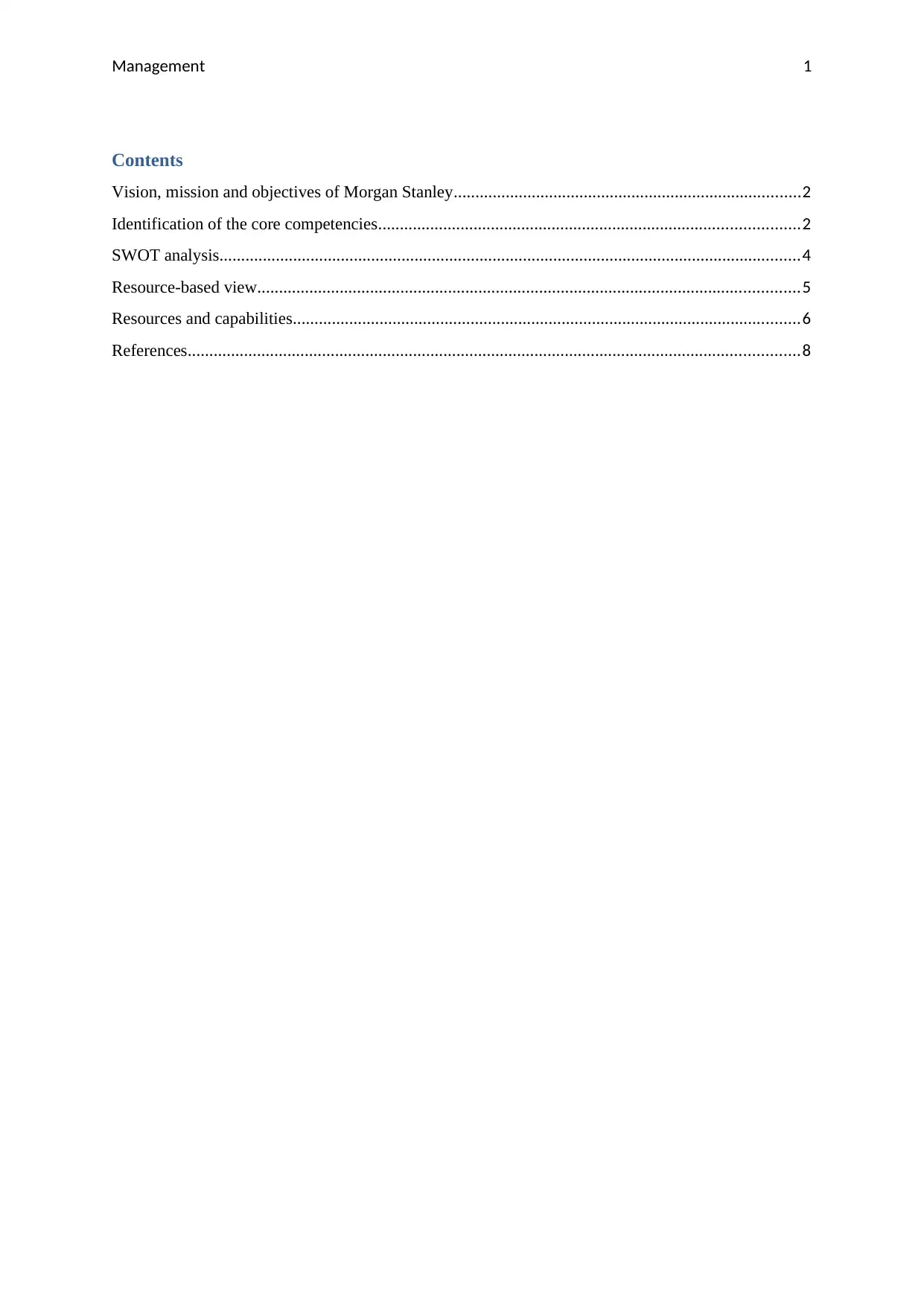
Management 1
Contents
Vision, mission and objectives of Morgan Stanley................................................................................2
Identification of the core competencies.................................................................................................2
SWOT analysis......................................................................................................................................4
Resource-based view.............................................................................................................................5
Resources and capabilities.....................................................................................................................6
References.............................................................................................................................................8
Contents
Vision, mission and objectives of Morgan Stanley................................................................................2
Identification of the core competencies.................................................................................................2
SWOT analysis......................................................................................................................................4
Resource-based view.............................................................................................................................5
Resources and capabilities.....................................................................................................................6
References.............................................................................................................................................8
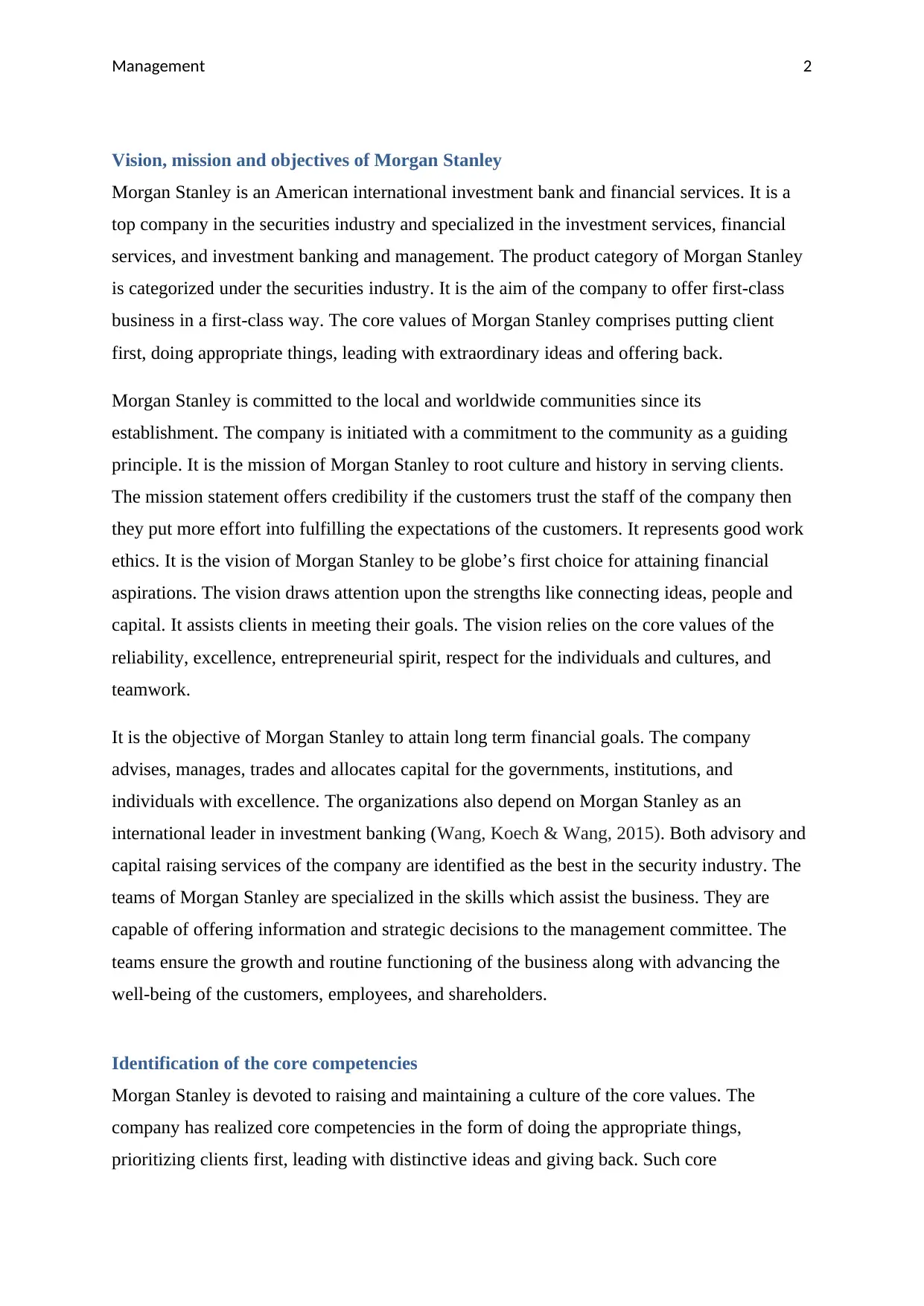
Management 2
Vision, mission and objectives of Morgan Stanley
Morgan Stanley is an American international investment bank and financial services. It is a
top company in the securities industry and specialized in the investment services, financial
services, and investment banking and management. The product category of Morgan Stanley
is categorized under the securities industry. It is the aim of the company to offer first-class
business in a first-class way. The core values of Morgan Stanley comprises putting client
first, doing appropriate things, leading with extraordinary ideas and offering back.
Morgan Stanley is committed to the local and worldwide communities since its
establishment. The company is initiated with a commitment to the community as a guiding
principle. It is the mission of Morgan Stanley to root culture and history in serving clients.
The mission statement offers credibility if the customers trust the staff of the company then
they put more effort into fulfilling the expectations of the customers. It represents good work
ethics. It is the vision of Morgan Stanley to be globe’s first choice for attaining financial
aspirations. The vision draws attention upon the strengths like connecting ideas, people and
capital. It assists clients in meeting their goals. The vision relies on the core values of the
reliability, excellence, entrepreneurial spirit, respect for the individuals and cultures, and
teamwork.
It is the objective of Morgan Stanley to attain long term financial goals. The company
advises, manages, trades and allocates capital for the governments, institutions, and
individuals with excellence. The organizations also depend on Morgan Stanley as an
international leader in investment banking (Wang, Koech & Wang, 2015). Both advisory and
capital raising services of the company are identified as the best in the security industry. The
teams of Morgan Stanley are specialized in the skills which assist the business. They are
capable of offering information and strategic decisions to the management committee. The
teams ensure the growth and routine functioning of the business along with advancing the
well-being of the customers, employees, and shareholders.
Identification of the core competencies
Morgan Stanley is devoted to raising and maintaining a culture of the core values. The
company has realized core competencies in the form of doing the appropriate things,
prioritizing clients first, leading with distinctive ideas and giving back. Such core
Vision, mission and objectives of Morgan Stanley
Morgan Stanley is an American international investment bank and financial services. It is a
top company in the securities industry and specialized in the investment services, financial
services, and investment banking and management. The product category of Morgan Stanley
is categorized under the securities industry. It is the aim of the company to offer first-class
business in a first-class way. The core values of Morgan Stanley comprises putting client
first, doing appropriate things, leading with extraordinary ideas and offering back.
Morgan Stanley is committed to the local and worldwide communities since its
establishment. The company is initiated with a commitment to the community as a guiding
principle. It is the mission of Morgan Stanley to root culture and history in serving clients.
The mission statement offers credibility if the customers trust the staff of the company then
they put more effort into fulfilling the expectations of the customers. It represents good work
ethics. It is the vision of Morgan Stanley to be globe’s first choice for attaining financial
aspirations. The vision draws attention upon the strengths like connecting ideas, people and
capital. It assists clients in meeting their goals. The vision relies on the core values of the
reliability, excellence, entrepreneurial spirit, respect for the individuals and cultures, and
teamwork.
It is the objective of Morgan Stanley to attain long term financial goals. The company
advises, manages, trades and allocates capital for the governments, institutions, and
individuals with excellence. The organizations also depend on Morgan Stanley as an
international leader in investment banking (Wang, Koech & Wang, 2015). Both advisory and
capital raising services of the company are identified as the best in the security industry. The
teams of Morgan Stanley are specialized in the skills which assist the business. They are
capable of offering information and strategic decisions to the management committee. The
teams ensure the growth and routine functioning of the business along with advancing the
well-being of the customers, employees, and shareholders.
Identification of the core competencies
Morgan Stanley is devoted to raising and maintaining a culture of the core values. The
company has realized core competencies in the form of doing the appropriate things,
prioritizing clients first, leading with distinctive ideas and giving back. Such core
⊘ This is a preview!⊘
Do you want full access?
Subscribe today to unlock all pages.

Trusted by 1+ million students worldwide
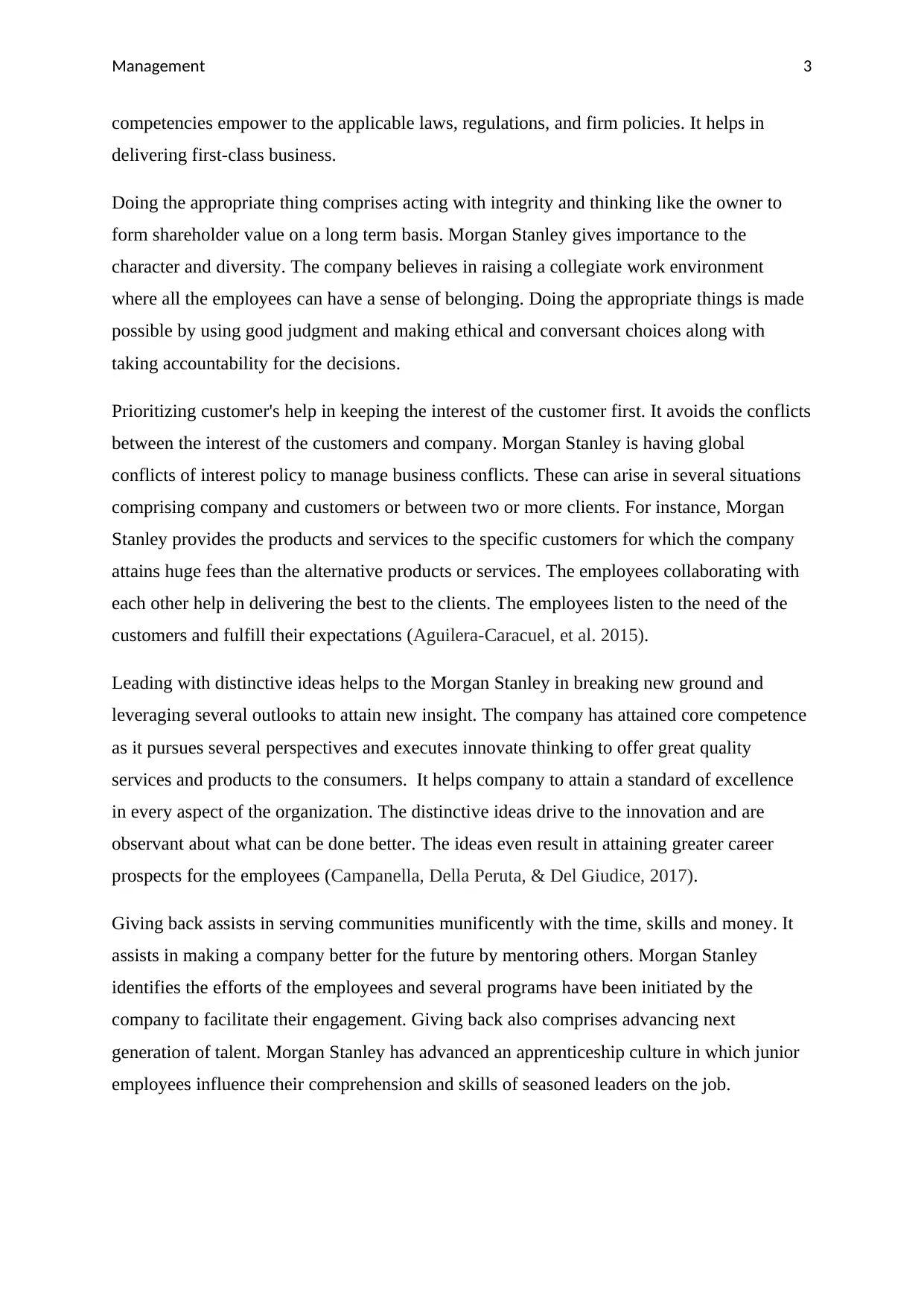
Management 3
competencies empower to the applicable laws, regulations, and firm policies. It helps in
delivering first-class business.
Doing the appropriate thing comprises acting with integrity and thinking like the owner to
form shareholder value on a long term basis. Morgan Stanley gives importance to the
character and diversity. The company believes in raising a collegiate work environment
where all the employees can have a sense of belonging. Doing the appropriate things is made
possible by using good judgment and making ethical and conversant choices along with
taking accountability for the decisions.
Prioritizing customer's help in keeping the interest of the customer first. It avoids the conflicts
between the interest of the customers and company. Morgan Stanley is having global
conflicts of interest policy to manage business conflicts. These can arise in several situations
comprising company and customers or between two or more clients. For instance, Morgan
Stanley provides the products and services to the specific customers for which the company
attains huge fees than the alternative products or services. The employees collaborating with
each other help in delivering the best to the clients. The employees listen to the need of the
customers and fulfill their expectations (Aguilera-Caracuel, et al. 2015).
Leading with distinctive ideas helps to the Morgan Stanley in breaking new ground and
leveraging several outlooks to attain new insight. The company has attained core competence
as it pursues several perspectives and executes innovate thinking to offer great quality
services and products to the consumers. It helps company to attain a standard of excellence
in every aspect of the organization. The distinctive ideas drive to the innovation and are
observant about what can be done better. The ideas even result in attaining greater career
prospects for the employees (Campanella, Della Peruta, & Del Giudice, 2017).
Giving back assists in serving communities munificently with the time, skills and money. It
assists in making a company better for the future by mentoring others. Morgan Stanley
identifies the efforts of the employees and several programs have been initiated by the
company to facilitate their engagement. Giving back also comprises advancing next
generation of talent. Morgan Stanley has advanced an apprenticeship culture in which junior
employees influence their comprehension and skills of seasoned leaders on the job.
competencies empower to the applicable laws, regulations, and firm policies. It helps in
delivering first-class business.
Doing the appropriate thing comprises acting with integrity and thinking like the owner to
form shareholder value on a long term basis. Morgan Stanley gives importance to the
character and diversity. The company believes in raising a collegiate work environment
where all the employees can have a sense of belonging. Doing the appropriate things is made
possible by using good judgment and making ethical and conversant choices along with
taking accountability for the decisions.
Prioritizing customer's help in keeping the interest of the customer first. It avoids the conflicts
between the interest of the customers and company. Morgan Stanley is having global
conflicts of interest policy to manage business conflicts. These can arise in several situations
comprising company and customers or between two or more clients. For instance, Morgan
Stanley provides the products and services to the specific customers for which the company
attains huge fees than the alternative products or services. The employees collaborating with
each other help in delivering the best to the clients. The employees listen to the need of the
customers and fulfill their expectations (Aguilera-Caracuel, et al. 2015).
Leading with distinctive ideas helps to the Morgan Stanley in breaking new ground and
leveraging several outlooks to attain new insight. The company has attained core competence
as it pursues several perspectives and executes innovate thinking to offer great quality
services and products to the consumers. It helps company to attain a standard of excellence
in every aspect of the organization. The distinctive ideas drive to the innovation and are
observant about what can be done better. The ideas even result in attaining greater career
prospects for the employees (Campanella, Della Peruta, & Del Giudice, 2017).
Giving back assists in serving communities munificently with the time, skills and money. It
assists in making a company better for the future by mentoring others. Morgan Stanley
identifies the efforts of the employees and several programs have been initiated by the
company to facilitate their engagement. Giving back also comprises advancing next
generation of talent. Morgan Stanley has advanced an apprenticeship culture in which junior
employees influence their comprehension and skills of seasoned leaders on the job.
Paraphrase This Document
Need a fresh take? Get an instant paraphrase of this document with our AI Paraphraser
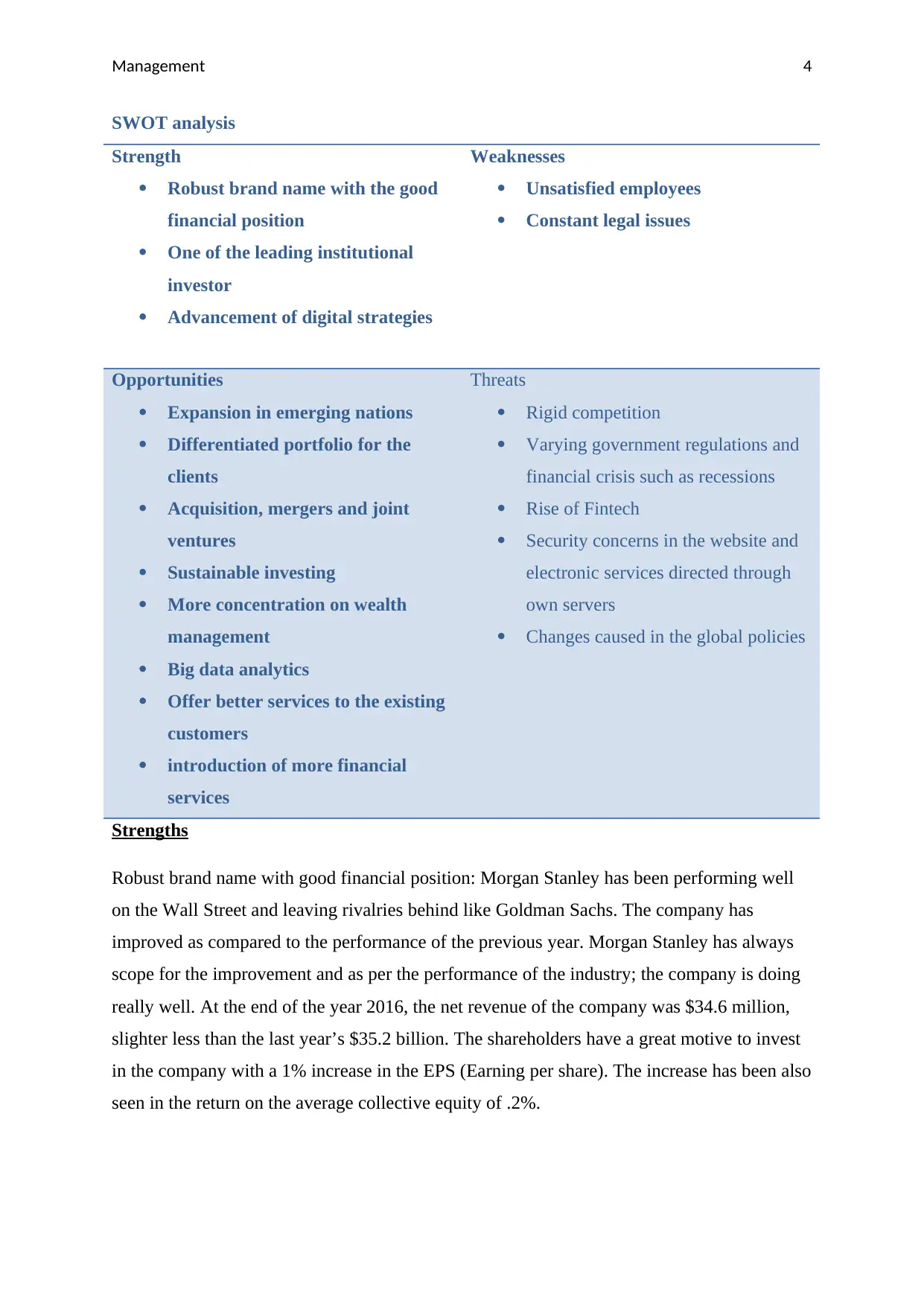
Management 4
SWOT analysis
Strength
Robust brand name with the good
financial position
One of the leading institutional
investor
Advancement of digital strategies
Weaknesses
Unsatisfied employees
Constant legal issues
Opportunities
Expansion in emerging nations
Differentiated portfolio for the
clients
Acquisition, mergers and joint
ventures
Sustainable investing
More concentration on wealth
management
Big data analytics
Offer better services to the existing
customers
introduction of more financial
services
Threats
Rigid competition
Varying government regulations and
financial crisis such as recessions
Rise of Fintech
Security concerns in the website and
electronic services directed through
own servers
Changes caused in the global policies
Strengths
Robust brand name with good financial position: Morgan Stanley has been performing well
on the Wall Street and leaving rivalries behind like Goldman Sachs. The company has
improved as compared to the performance of the previous year. Morgan Stanley has always
scope for the improvement and as per the performance of the industry; the company is doing
really well. At the end of the year 2016, the net revenue of the company was $34.6 million,
slighter less than the last year’s $35.2 billion. The shareholders have a great motive to invest
in the company with a 1% increase in the EPS (Earning per share). The increase has been also
seen in the return on the average collective equity of .2%.
SWOT analysis
Strength
Robust brand name with the good
financial position
One of the leading institutional
investor
Advancement of digital strategies
Weaknesses
Unsatisfied employees
Constant legal issues
Opportunities
Expansion in emerging nations
Differentiated portfolio for the
clients
Acquisition, mergers and joint
ventures
Sustainable investing
More concentration on wealth
management
Big data analytics
Offer better services to the existing
customers
introduction of more financial
services
Threats
Rigid competition
Varying government regulations and
financial crisis such as recessions
Rise of Fintech
Security concerns in the website and
electronic services directed through
own servers
Changes caused in the global policies
Strengths
Robust brand name with good financial position: Morgan Stanley has been performing well
on the Wall Street and leaving rivalries behind like Goldman Sachs. The company has
improved as compared to the performance of the previous year. Morgan Stanley has always
scope for the improvement and as per the performance of the industry; the company is doing
really well. At the end of the year 2016, the net revenue of the company was $34.6 million,
slighter less than the last year’s $35.2 billion. The shareholders have a great motive to invest
in the company with a 1% increase in the EPS (Earning per share). The increase has been also
seen in the return on the average collective equity of .2%.
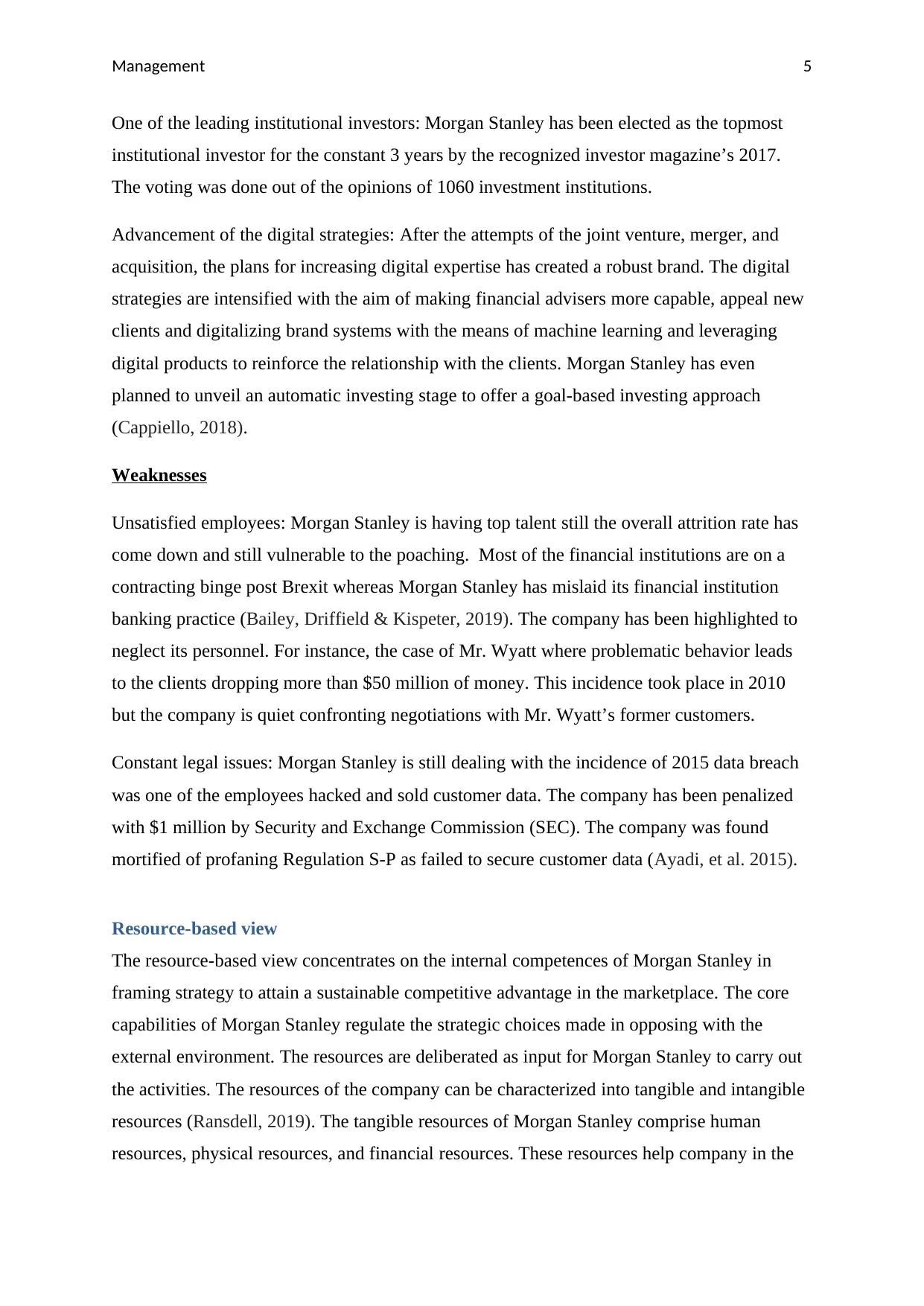
Management 5
One of the leading institutional investors: Morgan Stanley has been elected as the topmost
institutional investor for the constant 3 years by the recognized investor magazine’s 2017.
The voting was done out of the opinions of 1060 investment institutions.
Advancement of the digital strategies: After the attempts of the joint venture, merger, and
acquisition, the plans for increasing digital expertise has created a robust brand. The digital
strategies are intensified with the aim of making financial advisers more capable, appeal new
clients and digitalizing brand systems with the means of machine learning and leveraging
digital products to reinforce the relationship with the clients. Morgan Stanley has even
planned to unveil an automatic investing stage to offer a goal-based investing approach
(Cappiello, 2018).
Weaknesses
Unsatisfied employees: Morgan Stanley is having top talent still the overall attrition rate has
come down and still vulnerable to the poaching. Most of the financial institutions are on a
contracting binge post Brexit whereas Morgan Stanley has mislaid its financial institution
banking practice (Bailey, Driffield & Kispeter, 2019). The company has been highlighted to
neglect its personnel. For instance, the case of Mr. Wyatt where problematic behavior leads
to the clients dropping more than $50 million of money. This incidence took place in 2010
but the company is quiet confronting negotiations with Mr. Wyatt’s former customers.
Constant legal issues: Morgan Stanley is still dealing with the incidence of 2015 data breach
was one of the employees hacked and sold customer data. The company has been penalized
with $1 million by Security and Exchange Commission (SEC). The company was found
mortified of profaning Regulation S-P as failed to secure customer data (Ayadi, et al. 2015).
Resource-based view
The resource-based view concentrates on the internal competences of Morgan Stanley in
framing strategy to attain a sustainable competitive advantage in the marketplace. The core
capabilities of Morgan Stanley regulate the strategic choices made in opposing with the
external environment. The resources are deliberated as input for Morgan Stanley to carry out
the activities. The resources of the company can be characterized into tangible and intangible
resources (Ransdell, 2019). The tangible resources of Morgan Stanley comprise human
resources, physical resources, and financial resources. These resources help company in the
One of the leading institutional investors: Morgan Stanley has been elected as the topmost
institutional investor for the constant 3 years by the recognized investor magazine’s 2017.
The voting was done out of the opinions of 1060 investment institutions.
Advancement of the digital strategies: After the attempts of the joint venture, merger, and
acquisition, the plans for increasing digital expertise has created a robust brand. The digital
strategies are intensified with the aim of making financial advisers more capable, appeal new
clients and digitalizing brand systems with the means of machine learning and leveraging
digital products to reinforce the relationship with the clients. Morgan Stanley has even
planned to unveil an automatic investing stage to offer a goal-based investing approach
(Cappiello, 2018).
Weaknesses
Unsatisfied employees: Morgan Stanley is having top talent still the overall attrition rate has
come down and still vulnerable to the poaching. Most of the financial institutions are on a
contracting binge post Brexit whereas Morgan Stanley has mislaid its financial institution
banking practice (Bailey, Driffield & Kispeter, 2019). The company has been highlighted to
neglect its personnel. For instance, the case of Mr. Wyatt where problematic behavior leads
to the clients dropping more than $50 million of money. This incidence took place in 2010
but the company is quiet confronting negotiations with Mr. Wyatt’s former customers.
Constant legal issues: Morgan Stanley is still dealing with the incidence of 2015 data breach
was one of the employees hacked and sold customer data. The company has been penalized
with $1 million by Security and Exchange Commission (SEC). The company was found
mortified of profaning Regulation S-P as failed to secure customer data (Ayadi, et al. 2015).
Resource-based view
The resource-based view concentrates on the internal competences of Morgan Stanley in
framing strategy to attain a sustainable competitive advantage in the marketplace. The core
capabilities of Morgan Stanley regulate the strategic choices made in opposing with the
external environment. The resources are deliberated as input for Morgan Stanley to carry out
the activities. The resources of the company can be characterized into tangible and intangible
resources (Ransdell, 2019). The tangible resources of Morgan Stanley comprise human
resources, physical resources, and financial resources. These resources help company in the
⊘ This is a preview!⊘
Do you want full access?
Subscribe today to unlock all pages.

Trusted by 1+ million students worldwide
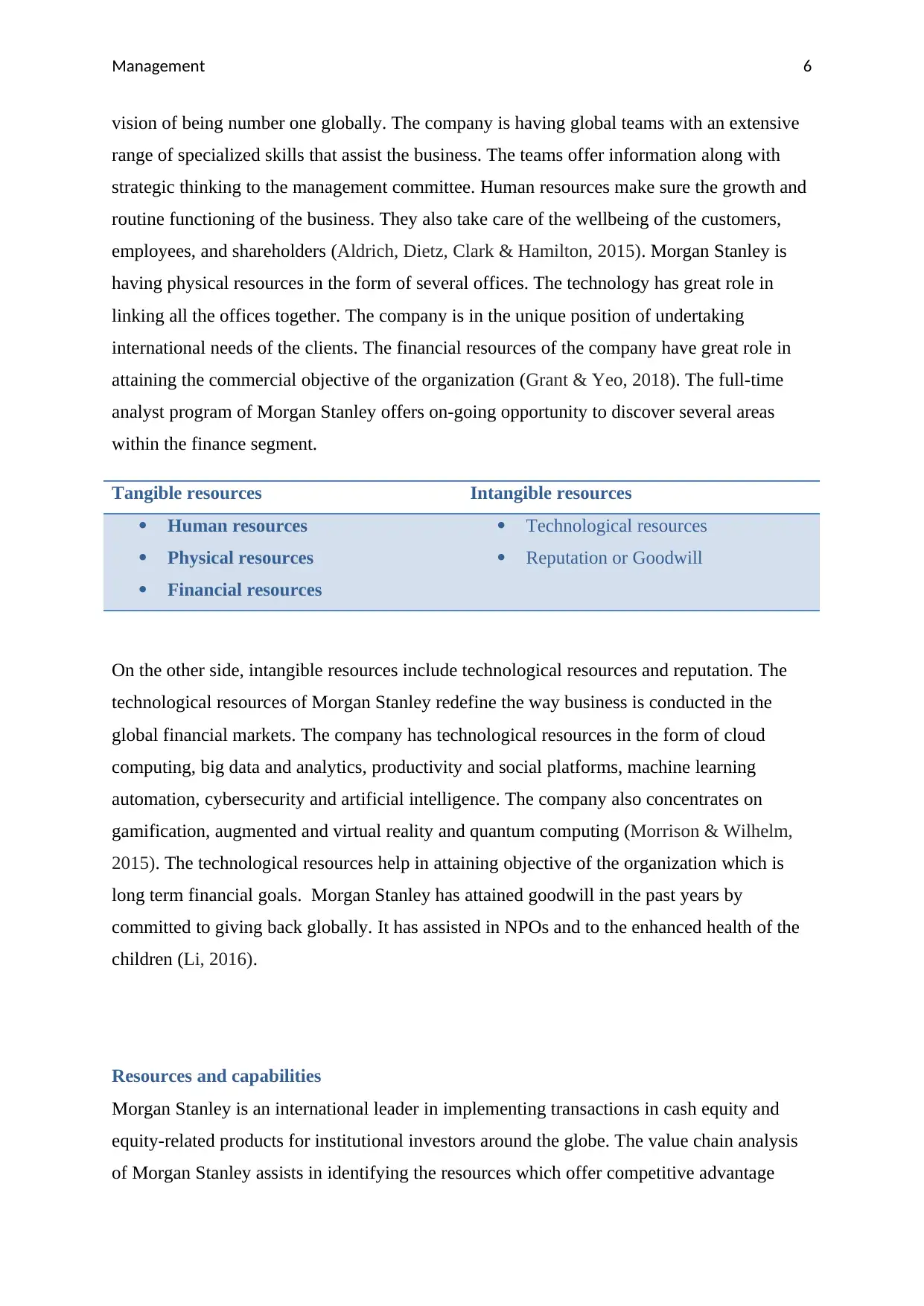
Management 6
vision of being number one globally. The company is having global teams with an extensive
range of specialized skills that assist the business. The teams offer information along with
strategic thinking to the management committee. Human resources make sure the growth and
routine functioning of the business. They also take care of the wellbeing of the customers,
employees, and shareholders (Aldrich, Dietz, Clark & Hamilton, 2015). Morgan Stanley is
having physical resources in the form of several offices. The technology has great role in
linking all the offices together. The company is in the unique position of undertaking
international needs of the clients. The financial resources of the company have great role in
attaining the commercial objective of the organization (Grant & Yeo, 2018). The full-time
analyst program of Morgan Stanley offers on-going opportunity to discover several areas
within the finance segment.
Tangible resources Intangible resources
Human resources
Physical resources
Financial resources
Technological resources
Reputation or Goodwill
On the other side, intangible resources include technological resources and reputation. The
technological resources of Morgan Stanley redefine the way business is conducted in the
global financial markets. The company has technological resources in the form of cloud
computing, big data and analytics, productivity and social platforms, machine learning
automation, cybersecurity and artificial intelligence. The company also concentrates on
gamification, augmented and virtual reality and quantum computing (Morrison & Wilhelm,
2015). The technological resources help in attaining objective of the organization which is
long term financial goals. Morgan Stanley has attained goodwill in the past years by
committed to giving back globally. It has assisted in NPOs and to the enhanced health of the
children (Li, 2016).
Resources and capabilities
Morgan Stanley is an international leader in implementing transactions in cash equity and
equity-related products for institutional investors around the globe. The value chain analysis
of Morgan Stanley assists in identifying the resources which offer competitive advantage
vision of being number one globally. The company is having global teams with an extensive
range of specialized skills that assist the business. The teams offer information along with
strategic thinking to the management committee. Human resources make sure the growth and
routine functioning of the business. They also take care of the wellbeing of the customers,
employees, and shareholders (Aldrich, Dietz, Clark & Hamilton, 2015). Morgan Stanley is
having physical resources in the form of several offices. The technology has great role in
linking all the offices together. The company is in the unique position of undertaking
international needs of the clients. The financial resources of the company have great role in
attaining the commercial objective of the organization (Grant & Yeo, 2018). The full-time
analyst program of Morgan Stanley offers on-going opportunity to discover several areas
within the finance segment.
Tangible resources Intangible resources
Human resources
Physical resources
Financial resources
Technological resources
Reputation or Goodwill
On the other side, intangible resources include technological resources and reputation. The
technological resources of Morgan Stanley redefine the way business is conducted in the
global financial markets. The company has technological resources in the form of cloud
computing, big data and analytics, productivity and social platforms, machine learning
automation, cybersecurity and artificial intelligence. The company also concentrates on
gamification, augmented and virtual reality and quantum computing (Morrison & Wilhelm,
2015). The technological resources help in attaining objective of the organization which is
long term financial goals. Morgan Stanley has attained goodwill in the past years by
committed to giving back globally. It has assisted in NPOs and to the enhanced health of the
children (Li, 2016).
Resources and capabilities
Morgan Stanley is an international leader in implementing transactions in cash equity and
equity-related products for institutional investors around the globe. The value chain analysis
of Morgan Stanley assists in identifying the resources which offer competitive advantage
Paraphrase This Document
Need a fresh take? Get an instant paraphrase of this document with our AI Paraphraser
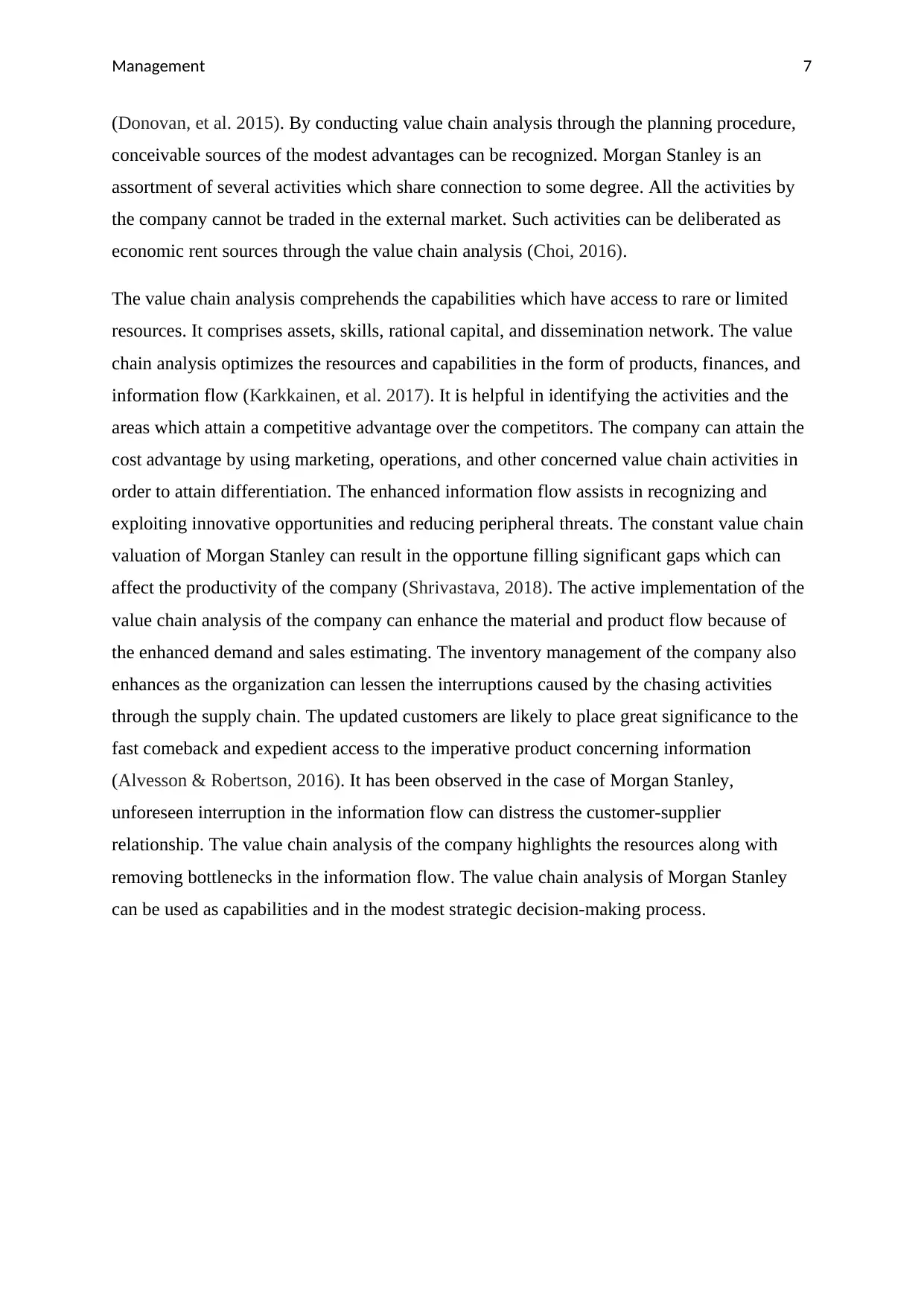
Management 7
(Donovan, et al. 2015). By conducting value chain analysis through the planning procedure,
conceivable sources of the modest advantages can be recognized. Morgan Stanley is an
assortment of several activities which share connection to some degree. All the activities by
the company cannot be traded in the external market. Such activities can be deliberated as
economic rent sources through the value chain analysis (Choi, 2016).
The value chain analysis comprehends the capabilities which have access to rare or limited
resources. It comprises assets, skills, rational capital, and dissemination network. The value
chain analysis optimizes the resources and capabilities in the form of products, finances, and
information flow (Karkkainen, et al. 2017). It is helpful in identifying the activities and the
areas which attain a competitive advantage over the competitors. The company can attain the
cost advantage by using marketing, operations, and other concerned value chain activities in
order to attain differentiation. The enhanced information flow assists in recognizing and
exploiting innovative opportunities and reducing peripheral threats. The constant value chain
valuation of Morgan Stanley can result in the opportune filling significant gaps which can
affect the productivity of the company (Shrivastava, 2018). The active implementation of the
value chain analysis of the company can enhance the material and product flow because of
the enhanced demand and sales estimating. The inventory management of the company also
enhances as the organization can lessen the interruptions caused by the chasing activities
through the supply chain. The updated customers are likely to place great significance to the
fast comeback and expedient access to the imperative product concerning information
(Alvesson & Robertson, 2016). It has been observed in the case of Morgan Stanley,
unforeseen interruption in the information flow can distress the customer-supplier
relationship. The value chain analysis of the company highlights the resources along with
removing bottlenecks in the information flow. The value chain analysis of Morgan Stanley
can be used as capabilities and in the modest strategic decision-making process.
(Donovan, et al. 2015). By conducting value chain analysis through the planning procedure,
conceivable sources of the modest advantages can be recognized. Morgan Stanley is an
assortment of several activities which share connection to some degree. All the activities by
the company cannot be traded in the external market. Such activities can be deliberated as
economic rent sources through the value chain analysis (Choi, 2016).
The value chain analysis comprehends the capabilities which have access to rare or limited
resources. It comprises assets, skills, rational capital, and dissemination network. The value
chain analysis optimizes the resources and capabilities in the form of products, finances, and
information flow (Karkkainen, et al. 2017). It is helpful in identifying the activities and the
areas which attain a competitive advantage over the competitors. The company can attain the
cost advantage by using marketing, operations, and other concerned value chain activities in
order to attain differentiation. The enhanced information flow assists in recognizing and
exploiting innovative opportunities and reducing peripheral threats. The constant value chain
valuation of Morgan Stanley can result in the opportune filling significant gaps which can
affect the productivity of the company (Shrivastava, 2018). The active implementation of the
value chain analysis of the company can enhance the material and product flow because of
the enhanced demand and sales estimating. The inventory management of the company also
enhances as the organization can lessen the interruptions caused by the chasing activities
through the supply chain. The updated customers are likely to place great significance to the
fast comeback and expedient access to the imperative product concerning information
(Alvesson & Robertson, 2016). It has been observed in the case of Morgan Stanley,
unforeseen interruption in the information flow can distress the customer-supplier
relationship. The value chain analysis of the company highlights the resources along with
removing bottlenecks in the information flow. The value chain analysis of Morgan Stanley
can be used as capabilities and in the modest strategic decision-making process.
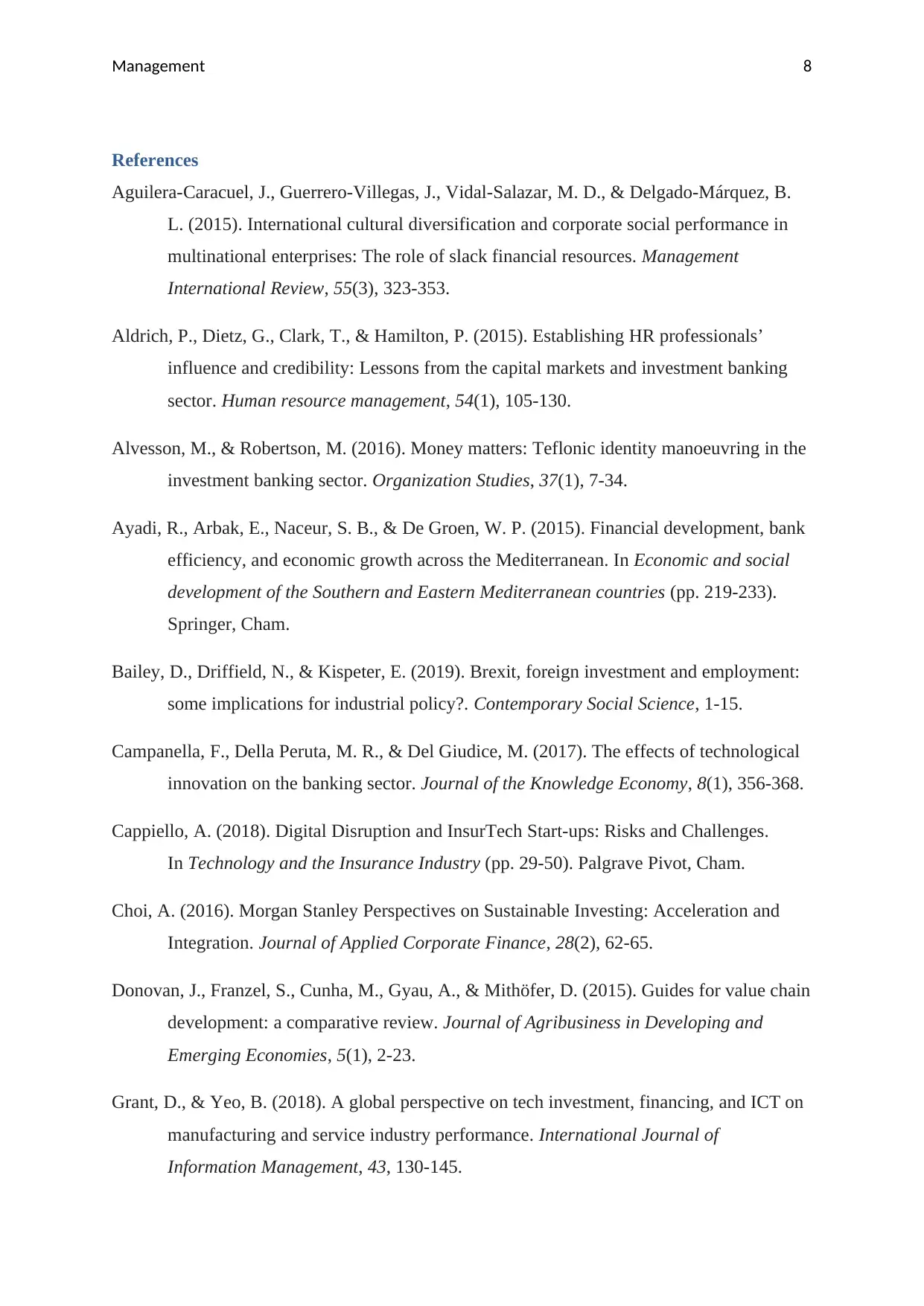
Management 8
References
Aguilera-Caracuel, J., Guerrero-Villegas, J., Vidal-Salazar, M. D., & Delgado-Márquez, B.
L. (2015). International cultural diversification and corporate social performance in
multinational enterprises: The role of slack financial resources. Management
International Review, 55(3), 323-353.
Aldrich, P., Dietz, G., Clark, T., & Hamilton, P. (2015). Establishing HR professionals’
influence and credibility: Lessons from the capital markets and investment banking
sector. Human resource management, 54(1), 105-130.
Alvesson, M., & Robertson, M. (2016). Money matters: Teflonic identity manoeuvring in the
investment banking sector. Organization Studies, 37(1), 7-34.
Ayadi, R., Arbak, E., Naceur, S. B., & De Groen, W. P. (2015). Financial development, bank
efficiency, and economic growth across the Mediterranean. In Economic and social
development of the Southern and Eastern Mediterranean countries (pp. 219-233).
Springer, Cham.
Bailey, D., Driffield, N., & Kispeter, E. (2019). Brexit, foreign investment and employment:
some implications for industrial policy?. Contemporary Social Science, 1-15.
Campanella, F., Della Peruta, M. R., & Del Giudice, M. (2017). The effects of technological
innovation on the banking sector. Journal of the Knowledge Economy, 8(1), 356-368.
Cappiello, A. (2018). Digital Disruption and InsurTech Start-ups: Risks and Challenges.
In Technology and the Insurance Industry (pp. 29-50). Palgrave Pivot, Cham.
Choi, A. (2016). Morgan Stanley Perspectives on Sustainable Investing: Acceleration and
Integration. Journal of Applied Corporate Finance, 28(2), 62-65.
Donovan, J., Franzel, S., Cunha, M., Gyau, A., & Mithöfer, D. (2015). Guides for value chain
development: a comparative review. Journal of Agribusiness in Developing and
Emerging Economies, 5(1), 2-23.
Grant, D., & Yeo, B. (2018). A global perspective on tech investment, financing, and ICT on
manufacturing and service industry performance. International Journal of
Information Management, 43, 130-145.
References
Aguilera-Caracuel, J., Guerrero-Villegas, J., Vidal-Salazar, M. D., & Delgado-Márquez, B.
L. (2015). International cultural diversification and corporate social performance in
multinational enterprises: The role of slack financial resources. Management
International Review, 55(3), 323-353.
Aldrich, P., Dietz, G., Clark, T., & Hamilton, P. (2015). Establishing HR professionals’
influence and credibility: Lessons from the capital markets and investment banking
sector. Human resource management, 54(1), 105-130.
Alvesson, M., & Robertson, M. (2016). Money matters: Teflonic identity manoeuvring in the
investment banking sector. Organization Studies, 37(1), 7-34.
Ayadi, R., Arbak, E., Naceur, S. B., & De Groen, W. P. (2015). Financial development, bank
efficiency, and economic growth across the Mediterranean. In Economic and social
development of the Southern and Eastern Mediterranean countries (pp. 219-233).
Springer, Cham.
Bailey, D., Driffield, N., & Kispeter, E. (2019). Brexit, foreign investment and employment:
some implications for industrial policy?. Contemporary Social Science, 1-15.
Campanella, F., Della Peruta, M. R., & Del Giudice, M. (2017). The effects of technological
innovation on the banking sector. Journal of the Knowledge Economy, 8(1), 356-368.
Cappiello, A. (2018). Digital Disruption and InsurTech Start-ups: Risks and Challenges.
In Technology and the Insurance Industry (pp. 29-50). Palgrave Pivot, Cham.
Choi, A. (2016). Morgan Stanley Perspectives on Sustainable Investing: Acceleration and
Integration. Journal of Applied Corporate Finance, 28(2), 62-65.
Donovan, J., Franzel, S., Cunha, M., Gyau, A., & Mithöfer, D. (2015). Guides for value chain
development: a comparative review. Journal of Agribusiness in Developing and
Emerging Economies, 5(1), 2-23.
Grant, D., & Yeo, B. (2018). A global perspective on tech investment, financing, and ICT on
manufacturing and service industry performance. International Journal of
Information Management, 43, 130-145.
⊘ This is a preview!⊘
Do you want full access?
Subscribe today to unlock all pages.

Trusted by 1+ million students worldwide
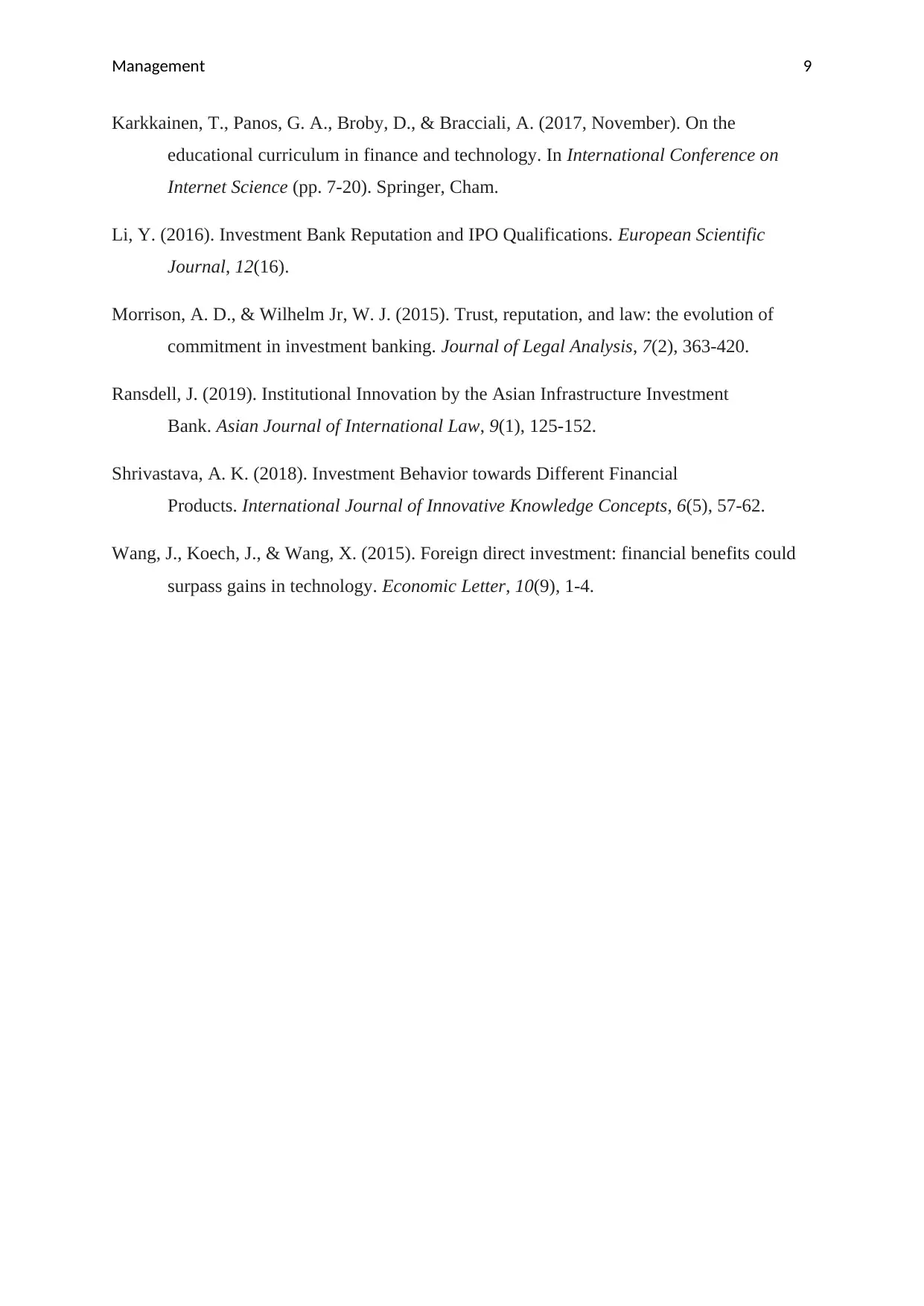
Management 9
Karkkainen, T., Panos, G. A., Broby, D., & Bracciali, A. (2017, November). On the
educational curriculum in finance and technology. In International Conference on
Internet Science (pp. 7-20). Springer, Cham.
Li, Y. (2016). Investment Bank Reputation and IPO Qualifications. European Scientific
Journal, 12(16).
Morrison, A. D., & Wilhelm Jr, W. J. (2015). Trust, reputation, and law: the evolution of
commitment in investment banking. Journal of Legal Analysis, 7(2), 363-420.
Ransdell, J. (2019). Institutional Innovation by the Asian Infrastructure Investment
Bank. Asian Journal of International Law, 9(1), 125-152.
Shrivastava, A. K. (2018). Investment Behavior towards Different Financial
Products. International Journal of Innovative Knowledge Concepts, 6(5), 57-62.
Wang, J., Koech, J., & Wang, X. (2015). Foreign direct investment: financial benefits could
surpass gains in technology. Economic Letter, 10(9), 1-4.
Karkkainen, T., Panos, G. A., Broby, D., & Bracciali, A. (2017, November). On the
educational curriculum in finance and technology. In International Conference on
Internet Science (pp. 7-20). Springer, Cham.
Li, Y. (2016). Investment Bank Reputation and IPO Qualifications. European Scientific
Journal, 12(16).
Morrison, A. D., & Wilhelm Jr, W. J. (2015). Trust, reputation, and law: the evolution of
commitment in investment banking. Journal of Legal Analysis, 7(2), 363-420.
Ransdell, J. (2019). Institutional Innovation by the Asian Infrastructure Investment
Bank. Asian Journal of International Law, 9(1), 125-152.
Shrivastava, A. K. (2018). Investment Behavior towards Different Financial
Products. International Journal of Innovative Knowledge Concepts, 6(5), 57-62.
Wang, J., Koech, J., & Wang, X. (2015). Foreign direct investment: financial benefits could
surpass gains in technology. Economic Letter, 10(9), 1-4.
1 out of 10
Related Documents
Your All-in-One AI-Powered Toolkit for Academic Success.
+13062052269
info@desklib.com
Available 24*7 on WhatsApp / Email
![[object Object]](/_next/static/media/star-bottom.7253800d.svg)
Unlock your academic potential
Copyright © 2020–2025 A2Z Services. All Rights Reserved. Developed and managed by ZUCOL.





